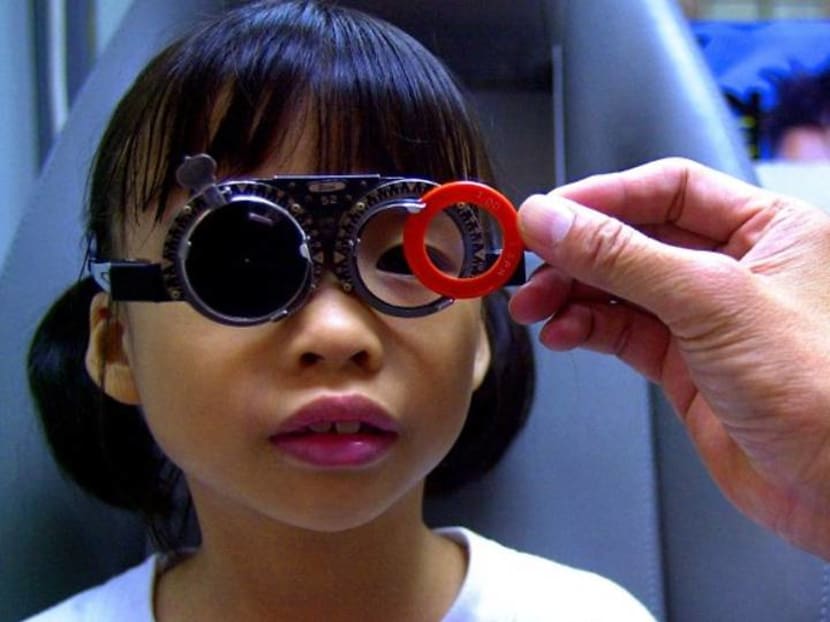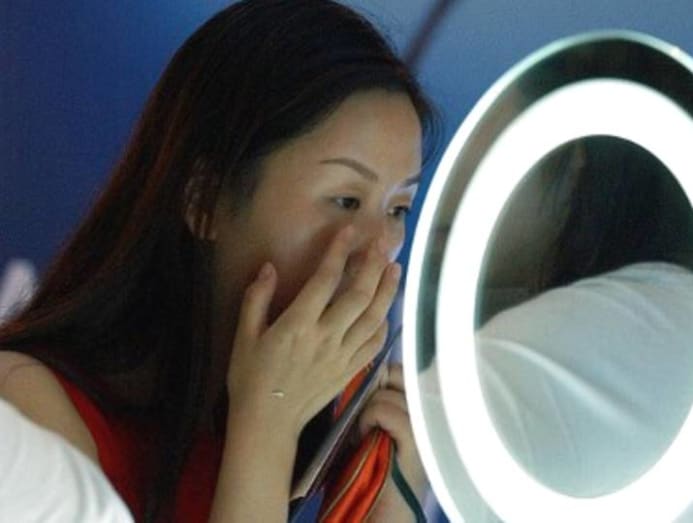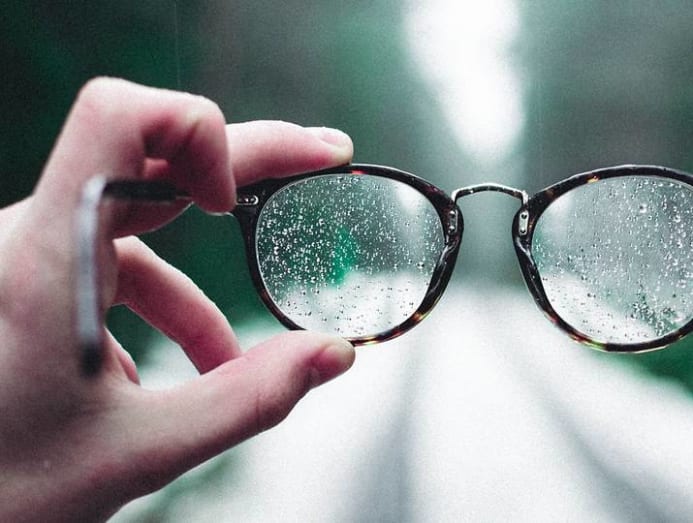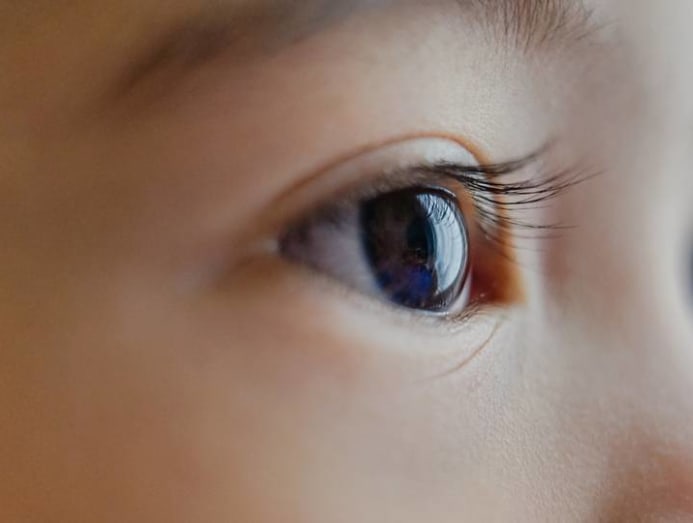commentary Commentary
Commentary: The pain of being a short-sighted Singaporean with no perfect fix
Perhaps, given that four out of five are myopic, we have a false sense of security as we feel safety in numbers, says eye expert Titus Wu.

A girl has her eyes checked at a local optician's shop in Singapore. (File photo: AFP/Alex Tan)
SINGAPORE: At a wedding dinner I recently attended, a friend asked me what she should do about her daughter’s rapid increase in myopia.
Just nine years of age, with 400 degrees, the girl was doing very well in her dance co-curriculum activity and wanted to perform without her spectacles. Her mother was concerned about starting her on soft contact lenses at such a young age and unsure about the safety of her daughter wearing the lenses from morning to night.
Before I could furnish a reply, another table-mate chimed in that her son had broken his spectacles thrice in the last six months playing soccer in school.
The costs and hassle of replacing his spectacles was burdensome, and his myopia was increasing at a steady state yearly, she lamented.
The gentleman next to her jumped in then, sharing his story of how his high myopia led to him urgently need cataract surgery in his forties. Cataract surgery is normally required when one is in their sixties, and he complained about how myopia had caused retina degeneration and his eyes to “age” prematurely.
With the table topic gaining ground, the lady to my right, a silver-haired dental specialist dressed to the nines chuckled as she said deadpanned:
One can afford to lose two teeth, but certainly can’t afford to lose two eyes.
She went on to share how she wished her parents had bothered more about helping her keep her myopia in check through her many years of studying to reach the top of her field because now, with 1,000 degrees, her options were limited to surgery and thick spectacles.
Lenses were too drying for her eyes, she complained, and spectacles often ruined her stylish ensemble.
“All work and no play makes Jane a very blind girl,” she quipped.

SHORT-SIGHTED NATION
Indeed, perhaps we study too much, or stare at our screens for too long, or perhaps it is a combination of factors and genetics, but the figures today are sobering. One in five of Singaporean children are myopic before they even start primary school.
The numbers grow alarmingly to half of the school-going population being affected by myopia. This percentage keeps increasing to 70 per cent in teenagers and 80 per cent in working adults.
This means that four out of five adults in Singapore suffer from short-sightedness. Out of the four, at least one has high myopia, which is more than 500 to upwards of 1,000 degrees.
READ: Young children with myopia at higher risk of poor vision, blindness: Study
This condition means that without the aid of spectacles or contact lenses, the unfortunate person would be stumbling around clumsily, virtually blind, only able to make out vague blurry forms and unable to discern letters, symbols or even facial expressions.
Not only that, but high myopia also brings higher risks of ocular complications such as cataract, retinal detachment, myopic macular degeneration, glaucoma, and in extreme and rare cases, blindness.
SOLUTIONS, SOLUTIONS
There is a smorgasbord of options available now to manage and to correct myopia.
Spectacles offer the simplest means of correcting vision, but they can be cumbersome during sporting and physical activities. Frequent changes of prescription and replacement of spectacles are also very common in children and teenagers due to the progression of myopia.
Soft disposable contact lenses, while providing great initial comfort and convenience, can lead to dryness if worn for a long period of time. In our hardworking society, the duration of our typical work and school days extend far beyond the recommended duration of lens wear.
The material used to make soft lenses can also potentially cause eye allergies and render the user “allergic” to their use. This can be mitigated with the use of appropriate lens care solutions and compliance.

READ: Some optometrists don't do eye checks before selling contact lenses, flouting code
Hard lenses perform the same duty as soft contact lenses but unlike the former, tend to provide better optics and eliminate the possibility of soft contact lens related allergies.
They do have their drawbacks – they are not disposable and require much maintenance like daily cleaning and proper storage. You have to rinse the lenses thoroughly daily, to ensure they would be sterile and safe for insertion into the eyes.
Some users also complain of initial discomfort of adjustment which can take weeks to months of getting used to.
Furthermore, accidentally dropping the lens and washing it down the sink or stepping on and shattering it are common occurrences when hard lens users, groggy from sleep, go through the motions of the daily cleaning regimen early in the morning.
Surgery is another option for adults. We have come a long way – research, technology and doctors’ skills have advanced tremendously to achieve favourable results.
However, not everyone qualifies for surgery. Some are also squeamish about going under the knife.
Besides spectacles, contacts lenses and surgery, less commonly-known solutions for myopia management include eye drops, scleral lenses and specialty lens treatment programmes like orthokeratology.

The two concerned mothers, knowing that I ran a speciality lens clinic, wanted to know more about orthokeratology. Worn only while the patient is sleeping, it functions like braces for the eyes where a hard lens gently reshapes the cornea at night to achieve clear vision without the use of spectacles or contact lenses in the day.
This, however, is not some miraculous catchall solution, I was quick to disclaim. For one, while it can control the progression of myopia, we cannot claim that it can help reduce the actual level of myopia.
For another, the inconveniences were similar to that of hard lenses whereby patient adherence to strict hygiene practice was paramount. You also had to wear the lenses for a minimum of six hours a night.
My wife chimed in then. She had broken and replaced multiple pairs of spectacles as a child. She switched to contact lenses for a decade but could only wear them for half a day at a time because they became dry and irritated her eyes.
She had tried orthokeratology but stopped because she was breastfeeding and it was impossible to get six hours of uninterrupted sleep at night. She even went to consult a doctor on the possibility of surgery but was too afraid to commit to the finality of it.
“How then? What do you use now?” The mother of the spectacles-breaking boy was eager to know.
“I interchange between spectacles, disposable contact lenses, and sometimes just make do with my state of semi-blindness,” said my wife to the mirth of the others.
The moral of the story – myopia is a very real and ubiquitous problem that we certainly need to pay more attention to. Perhaps, given that four out of five are myopic, we have a false sense of security as we feel safety in numbers.

As there is no one-size-fits-all solution to myopia, we need to take better care of our eyes and accept that there’s no such thing as a convenient solution in our conversation about myopia and its treatment options.
All we can do is weigh the various options available to us and choose wisely based on our lifestyle requirements. In the case of my wife, she’s lucky she has me to fetch her spectacles when she’s stumbling around as if drunk.
Titus Wu is a fellow of the international academy of orthokeratology and myopia control. His area of clinical interests includes myopia control for children and cornea and vision rehabilitation using speciality lenses.





